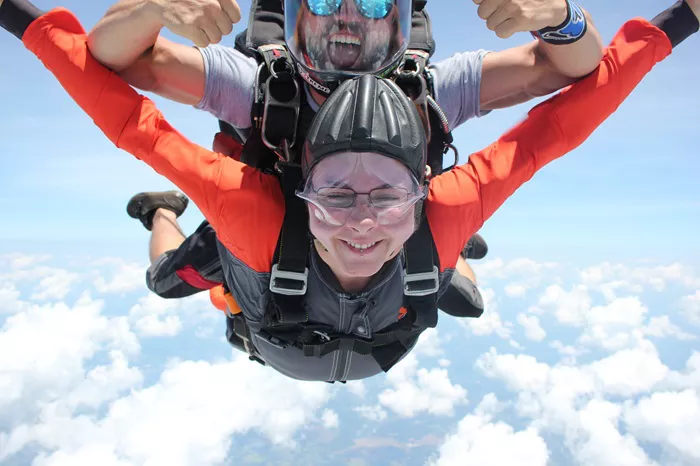Solo skydiving represents the pinnacle of thrill-seeking and adventure, offering individuals the ultimate freedom of flight. Unlike tandem jumps where you’re securely attached to an instructor, solo skydiving demands mastery of skills, meticulous preparation, and unwavering commitment to safety protocols. This comprehensive guide dives into the journey from novice to solo jumper, exploring the essential requirements, rigorous training, crucial equipment, mental preparation strategies, safety procedures, and the vibrant community that defines the world of solo skydiving.
Understanding the Basics of Solo Skydiving
Solo skydiving isn’t just about jumping out of a plane alone—it’s about understanding the intricacies of freefall, parachute deployment, and safe landing techniques. This section lays the groundwork for aspiring solo jumpers by delving into the fundamental aspects of the sport. From the physics of freefall to the aerodynamics of canopy flight, solo skydiving requires a solid grasp of its core principles.
Requirements and Prerequisites
Before taking flight solo, there are several prerequisites that every skydiver must meet. Age restrictions typically require jumpers to be at least 18 years old, ensuring maturity and legal consent. Health considerations are paramount, with drop zones often requiring medical clearance to ensure jumpers can handle the physical demands of skydiving. Training prerequisites involve completing an accredited skydiving training program, which equips jumpers with the knowledge and skills necessary for safe solo jumps. Additionally, experience requirements mandate a series of supervised jumps to ensure proficiency in handling various skydiving scenarios independently.
Training and Certification
Becoming a solo skydiver begins with thorough training under the guidance of certified instructors. Ground school lays the foundation by covering essential theoretical knowledge, including equipment use, emergency procedures, and the physics of freefall. Tandem jumps with instructors provide hands-on experience and build confidence in executing maneuvers like stable body positioning and altitude awareness. Accelerated Freefall (AFF) courses are structured programs that progressively reduce instructor assistance, allowing jumpers to demonstrate their ability to handle freefall, canopy deployment, and landing procedures independently.
Gearing Up: Understanding Skydiving Equipment
Skydiving equipment is meticulously designed and rigorously maintained to ensure safety and reliability. The main components of a skydiving rig include the main parachute and reserve parachute, both packed according to strict procedures to guarantee proper deployment in case of emergencies. Altitude awareness devices such as altimeters and audible altimeters provide crucial information during the jump, helping jumpers monitor altitude and make timely decisions. Safety gear like helmets, goggles, and jumpsuits protect against the elements and enhance comfort during freefall and canopy flight.
Mental Preparation: Overcoming Fear and Building Confidence
Solo skydiving requires not just physical preparation but also mental fortitude. Fear management techniques help jumpers cope with pre-jump anxiety, ensuring they can make clear-headed decisions during the jump. Visualization exercises mentally rehearse the sequence of actions from exit to landing, enhancing muscle memory and confidence in executing procedures under pressure. Maintaining a positive mindset fosters resilience, empowering jumpers to embrace challenges and learn from each experience, whether successful or challenging.
Safety First: Protocols and Procedures
Safety is paramount in skydiving, especially when jumping solo. Pre-jump checks involve meticulous inspections of equipment to ensure everything is in working order and properly secured. Emergency protocols outline procedures for responding to equipment malfunctions, including emergency exits and reserve parachute deployments. Drop zone regulations govern airspace usage, landing patterns, and operational protocols, ensuring a safe and organized environment for solo and tandem jumpers alike.
see also: Mastering The Skies: How Long Does Tandem Skydiving Training Take?
Taking the Leap: From Exit to Landing
Executing a solo skydive involves mastering several critical phases, each requiring precision and skill. The exit from the aircraft demands a controlled departure to maintain stability and prevent spin or tumble. During freefall, maintaining a stable body position optimizes control and reduces air resistance, prolonging the descent before deploying the parachute. Canopy flight involves deploying the parachute at the correct altitude, controlling direction and speed using toggle inputs, and setting up for a safe landing approach. Landing is perhaps the most critical phase, requiring accurate judgment of wind conditions, precise canopy control, and a flare maneuver to cushion the landing and prevent injury.
Progression and Mastery: Continuing Education and Skill Development
Solo skydiving is a journey of continuous learning and improvement. Advanced skills workshops teach techniques such as turns, flips, and formations, enabling jumpers to expand their aerial repertoire and engage in group skydiving activities. Specialized training programs offer opportunities to explore disciplines like wingsuit flying, formation skydiving, and canopy piloting, each requiring specialized knowledge and proficiency. Progressing through skydiving license levels, from novice to expert, unlocks new privileges and responsibilities, fostering a deeper understanding of skydiving principles and safety protocols.
Community and Camaraderie: The Skydiving Culture
Skydiving transcends individual pursuits to foster a vibrant community united by a shared passion for flight and adventure. Drop zones serve as hubs of activity where skydivers from all walks of life come together to share experiences, exchange knowledge, and celebrate milestones. Events such as boogies, competitions, and record attempts provide opportunities for camaraderie and friendly competition, showcasing the diversity and spirit of the global skydiving community. Whether jumping locally or exploring drop zones worldwide, solo skydivers forge lasting friendships and connections that enrich their skydiving journey beyond the thrill of the jump itself.
Conclusion
Solo skydiving isn’t merely an extreme sport; it’s a transformative experience that challenges individuals to push their limits, conquer fears, and discover new dimensions of freedom and self-reliance. From the exhilaration of freefall to the serenity of canopy flight, solo skydiving offers a unique perspective on the world from thousands of feet above. Embracing the discipline of training, the thrill of flight, and the camaraderie of fellow jumpers, solo skydiving opens doors to a lifelong journey of adventure, exploration, and personal growth.
related topics:
- Mastering The Skies: How Long Does Tandem Skydiving Training Take?
- Exploring The Mechanics Of Indoor Skydiving: How Does It Work?
- Exploring The Causes Of Skydiving Fatalities: Understanding Risks And Prevention Strategies

